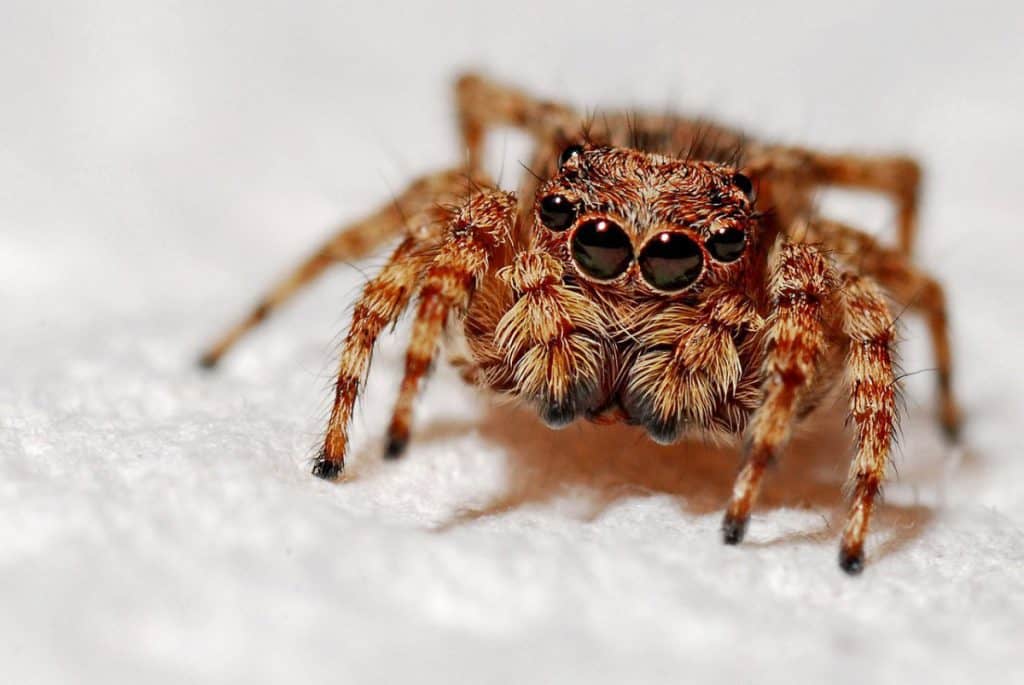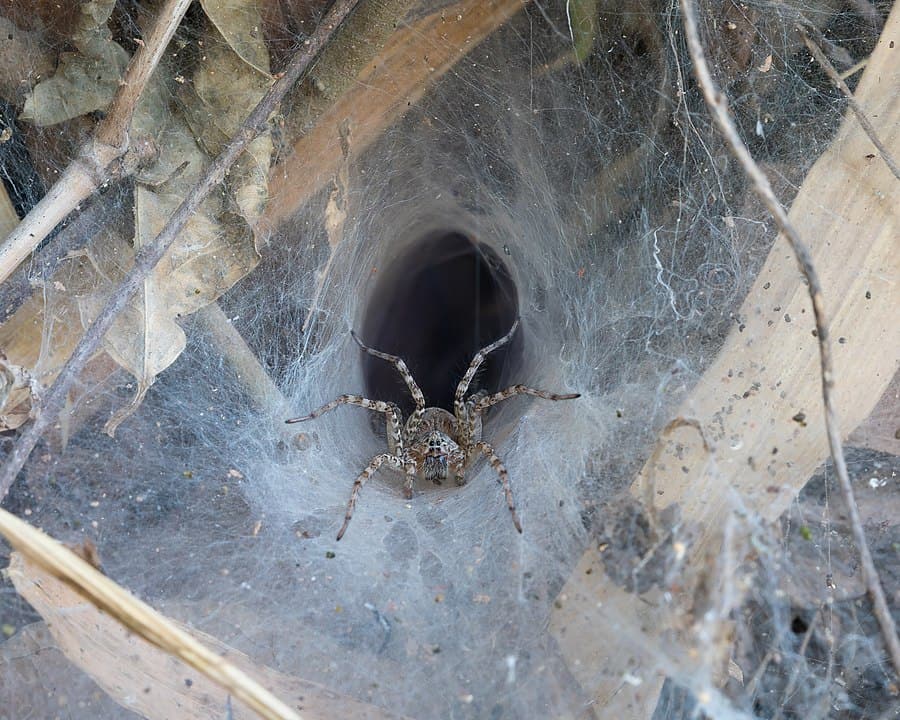
If you enjoy reading this article, why not check out our articles on Do Spiders Hibernate? Let’s Find Out and Do Male Spiders Spin Webs? Not What You Expected.
Do tarantulas bite?
Pet tarantulas seem pretty docile and are usually not aggressive to humans. However, they are still wild animals and if they feel threatened, they can attack with a bite. New World tarantulas (from the American continent) developed a second defense mechanism, which consists of releasing urticating hairs from their abdomen. When tarantulas bite, they prefer to save their venom for eating. This is why they sometimes defend themselves with a dry bite (without injecting venom).
If you’re serious about having a pet tarantula, take a look at How Much Does Owning a Tarantula Cost? to help you make up your mind.
Do pet tarantulas recognize their owners?
New World tarantulas sometimes defend themselves by scratching their abdomen with their hind legs to release its abdomen hair, which starts floating and spreading through the air. “The hairs can cause painful skin rashes and excruciating lung and eye injuries.”1
Although the venom of tarantulas can kill larger animals than itself, its level of toxicity is not considered dangerous for humans. For a person, its bite can be compared to the sting of a bee. It hurts, the skin turns red and starts swelling. People who are allergic to the venom must go to the emergency room immediately. No person has ever been reported to die from the bite of a tarantula.
How Do Tarantulas Attack?
If a tarantula shows its fangs, it is either scared or about to eat. Tarantulas can move its fangs independently. They can roll them towards themselves (like folding two fingers of a human hand) or extend them (when they are going to attack). When it is going to eat, it grabs the prey with its front legs, unfolds its fangs and inserts them in the victim. Ever curious about whether tarantulas can grow back their fangs? Find out in Can Spider Fangs Grow Back? Let’s Find Out.
Is it dangerous? Does their bite hurt much?
“If these creatures feel threatened, they will raise their front legs to make themselves look bigger, even though they are already rather large.”2 At this point, it is about to attack if the threat continues. When it is in your hand and you disturb it, it may simply bite you quickly without warning.
When it is going to release urticating hair, it may either raise its abdomen and start scratching it with its hind legs or simply scratch it without changing its position. It happens very quickly. Only two or three scratches release enough hair to cause severe irritation in the victim.
What Provokes a Tarantula to Bite?
Tarantulas have no intrinsic interest in attacking humans. They will only do this to defend themselves. You should never bother a tarantula or try to play with it because it will interpret this as aggression. If you leave tarantulas alone, they will not attack you. If a tarantula happens to land on you, the best thing you can do is not move and wait for it to walk away. If you try to hit it, the tarantula will feel threatened and defend itself.
Can a Pet Tarantula Bite Without Provocation?
Domesticated animals have learned to be controlled by humans. Some of them even become friends with people (like dogs). However, wild animals are very different. They simply cannot understand what “friendship” means, regardless of how well you treat them. They want to eat when they are hungry and they have their aggressive natural instinct to survive.
Is it possible to gain the trust of tarantulas
Tarantulas are wild animals. No matter how well you feed and treat your pet tarantula, it will always treat you like a stranger. Even if the tarantula is trained to behave calmly, it will not create any type of bond with its owners. You must always handle your pet tarantula with caution (and the least amount of time possible). If it feels threatened, it will attack you.
Tarantulas defend themselves with the help of needle-like hairs
The senses of a tarantula are very different than ours. They have very poor eyesight and they use the hair on their body and their legs to detect vibrations. They also perceive smell, vibrations, and taste. through the ends of their legs. Because of its hunting techniques (perceiving when a prey touches their silk), a tarantula is very sensitive to touch. A pet tarantula could misinterpret your intentions and feel threatened, even when you are not trying to provoke it. Do not try to force it too much to go to a certain place. Let it take its time. Never poke it. Do not move quickly when you are holding it or it will bite you without warning. Some people prefer not to touch tarantulas or carry them on their hands or shoulders.
Tarantulas are sensitive and rarely bite
“As a tarantula grows, it must shed its old stiff exoskeleton.”3 When they do this, their new one is much softer and more sensitive for the next few days (until it hardens). Because of this softness, they are especially vulnerable to their predators during this period. Your pet tarantula could be more easily provoked during this time because of its sudden keen sensitivity. If it molts, be very careful when handling it for the next few days.
Are Some Species of Tarantulas More Aggressive than Others?

“The 2009 World Spider Catalog (from the American Museum of Natural History) lists 920 known tarantula species.”4 They are found in the tropical, subtropical, and desert regions of the Earth. They can be divided into two categories;
- Arboreal tarantulas (which live on trees and have brighter colors)
- Terrestrial tarantulas (which live in burrows on the ground and have longer legs).
Are tarantulas dangerous?
The aggressiveness of tarantulas varies in each hemisphere of the world. There are old-world tarantulas (from Europe, Asia, Africa, and Australia) and new world tarantulas (from the American Continent). New World tarantulas have milder venom and the urticating hair defense mechanism. Old world tarantulas have a stronger venom (which still cannot kill humans) and no urticating hairs. Old world tarantulas tend to be more aggressive and bite more often when defending themselves.
Different species of tarantulas
| Name of Tarantula | Behavior of Species |
| Chilean Rose Hair Tarantula | calm, slow, docile |
| Mexican Redknee | a bit faster than the Chilean Rose hair |
| Cobalt Blue Tarantula | very aggressive |
| Goliath Bird-Eating Tarantula | aggressive |
| Fringed Ornamental Tarantula | aggressive, elusive, and hard to handle |
| Greenbottle Blue Tarantula | fast and nervous terrestrial tarantula |
The different species have different temperaments. There are some tarantulas that are known as easy for beginners (new world tarantulas) because they are calm, slow, docile, and reluctant to bite people. The Chilean Rose Hair Tarantula (Gramostola rosea) is an example. Some people may find it boring because it moves slowly and is not very active.
However, it is safer to handle than the rest. The Mexican Redknee (Brachipelma smithi) is another good choice for beginners. However, it is a little bit faster than the first one.
People with more experience with tarantulas like to buy other more colorful or aggressive species. The Cobalt Blue Tarantula (Haplopelma lividum) is famous for its blue color, but it is very aggressive and does not like to be handled. The Goliath Bird-Eating Tarantula (Theraphosa blondi) is enormous, aggressive, and can eat rats and some snakes.
The Fringed Ornamental Tarantula (Poecilotheria ornata) has a very interesting coloration but is aggressive, elusive, and extremely hard to handle. The Greenbottle Blue Tarantula (Chromatopelma cyaneopubescens) is a fast and nervous terrestrial tarantula that is especially beautiful for its bright colors (blue legs, green body and orange abdomen).
What to Do if You Are Bitten By a Tarantula?
If you get bitten by a tarantula, go to the emergency room immediately. Even when you know that you are not going to die, it is better to play it safe and receive instructions from the doctors that attend you, in case this occurs again in the future. They will even give you the right medicine if you happen to be allergic to the venom.
Are tarantula bites poisonous?
If you decide not to go to the hospital, it is recommended to wash with soap and water, take a pill for the pain (if needed), and put ice over the place where it bit you. If you start feeling dizzy and start having difficulty breathing, you may be allergic to the venom and will have to go to the emergency room.
If the hairs of the tarantula are irritating your skin, do not scratch the affected area. Pour some running water and use something wet or sticky to pull them off by pressing and releasing. The hairs are too small to be seen, so it may be very hard to use tweezers.
Can You Cut Off the Fangs a Tarantula?
“Disarming” a tarantula will kill it slowly. Tarantulas use their fangs to inject venom and digestive enzymes which paralyze, digest, and liquefy their prey. After the once-solid prey turns to liquid, they eat it by sucking its liquid. Without their fangs, they cannot eat and literally starve to death. Even if this could be done, they can still use their other method of defense (urticating hairs). Tarantulas cannot be harmless pets.
Conclusion
If you have a pet tarantula and you are wondering if it will bite you, remember that it cannot understand that it is your pet. You may become familiar with the things that it likes and dislikes, but it will still attack you if it feels threatened.
Each species has a different degree of aggressiveness. There may be species that you may prefer never to handle. If you want to be safe, never touch or bother a tarantula. They are not interested in attacking people (despite the way they look).
Although their venom won’t kill humans, their bite is still painful (like the sting of a bee) and their hair is extremely irritating (especially in the eyes, nose, and mouth). Depending on the species, the pain may last several days. It is important to know well your tarantula before you handle it.
References
- Weisman, D. (2010) Tarantula! Retrieved from: https://tpwmagazine.com/archive/2010/mar/ed_3/index.phtml
- H. J. (2019) How Deadly is a Tarantula? Retrieved from: https://youngzine.org/news/our-earth/how-deadly-tarantula
- Rankin, A. (2018) Watch a Time-Lapse of a Tarantula Crawling out of its Own Skin. Retrieved from: https://www.nationalgeographic.com/news/2018/05/tarantula-shedding-molting-video-timelapse-slow-motion-animals-spd/
- Weisman, D. (2010) Tarantula! Retrieved from: https://tpwmagazine.com/archive/2010/mar/ed_3/index.phtml
If you enjoyed reading this article, why not check out our articles on The Three Best Kinds of Spiders to Keep as Pets and Which Bugs Make the Best Pets? The Complete Guide
Recent Posts
Tiny Black Bugs in Bathroom NO WINGS: What They Are and What to Do!
Finding tiny black bugs in your bathroom can be uncomfortable, to say the least. Especially if they are persistent, or they appear in very large numbers, which they often like to do. When it...
Tiny Black Bugs in Plant Soil - What Are They & What To Do About It
A short horror story: You get a new houseplant. You do your best to take care of it. You’ve ensured that it has the right soil, the right amount of sun, it gets enough water. And then one day, you...

